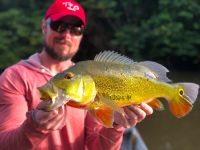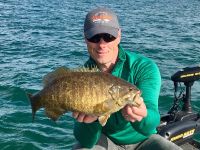Fd: Can you tell us a bit about how the idea of setting up a fly-fishing operation came up?
I’ve wanted to be a guide since middle school. However, as I got older, I was convinced by people older than me (adults) that there was no money in guiding. So, I took advantage of my strengths in mathematics and planning and joined the United States Marine Corps after graduating college. While I was on active duty, travelling the world and deploying to combat, guiding always remained in the back of my mind as an option later in life. I fished all over the country on as many waters as possible trying to hone my skills and meet others that could teach me new tactics and techniques. 16 years later, I realized I wasn’t getting any younger and decided to take the big step of starting a guide service. Best decision of my life.
Fd: What would you say to those who never tried fly fishing in your areas?
For most of the year, fishing in the Buffalo Niagara region is relatively easy for fly anglers. Our walk and wade fishery rarely requires long casts or a wide array of flies. If you can throw a streamer 40 feet or you know how to fish under an indicator – you’ll be fine. From September though May, you can expect to catch huge fish while walking our regional creeks. Pike, lake run brown trout, chinook salmon, coho salmon, smallmouth bass, and steelhead are all there at various points throughout this period. The biggest problem is deciding which one you want to target!
Fd: During which months are the seasons open over there?
Buffalo Niagara is an angler’s paradise. Every season fishes well and each season offers a new species and way to fish. We get all four seasons with respect to the weather. It’s cold in the winter, mild and wet in the spring, hot and windy in the summer, and near perfect in the fall. Each season demands new techniques, rod reel combos, flies, and apparel to remain comfortable and successful on the water.
Fd: What kind of fly-fishing gear should anglers take over there?
Ideally nothing – if you go fishing with us, we provide you everything you would need for a successful day. However, if you’re trying to do a DIY trip, you’d be fine for most of the year with a 9ft 7wt with floating line and sinking leaders. The only exception to this is in the fall when fishing for salmon – you need a 10wt for that.
Fall through spring, you need waders.
Fd: What are the top 5 flies that should be included in our boxes?
Smallies – tan colored crawfish patterns that sink quick.
Salmon – white deceivers with plenty of flash.
Steelhead and Lake Run Browns – sculpin patterns and egg patterns.
Carp – neutrally buoyant crustacean patterns.
Fd: How are the day programmes?
Link up at dawn. Fish hard ’til noon. Grab lunch. Fish hard ’til around 4. Call it a day. Depending on the time of the year, we may cover numerous creeks in search of that prime pool that’s holding a ton of fish. That entails a good deal of walking or driving from spot to spot. If we’re fishing from the boat, we’ll likely cover a ton of water in Lake Erie, the Niagara River, or Lake Ontario (or all in one day) pursuing our quarry.
Fd: What about the lodging options in the area?
The Buffalo Niagara region is a major metropolis. There are lodging accommodations for every taste and budget.
Fd: Any other advice for those visiting you?
Take the time to visit at least a few breweries. Visitors should also dedicate at least a half day to exploring Niagara Falls.
Fd: Any upcoming videos?
We have a film festival project in the works for this fall. Editing is almost complete.
Contact Ryan Shea through our Travel Directory, right here: Travel.














